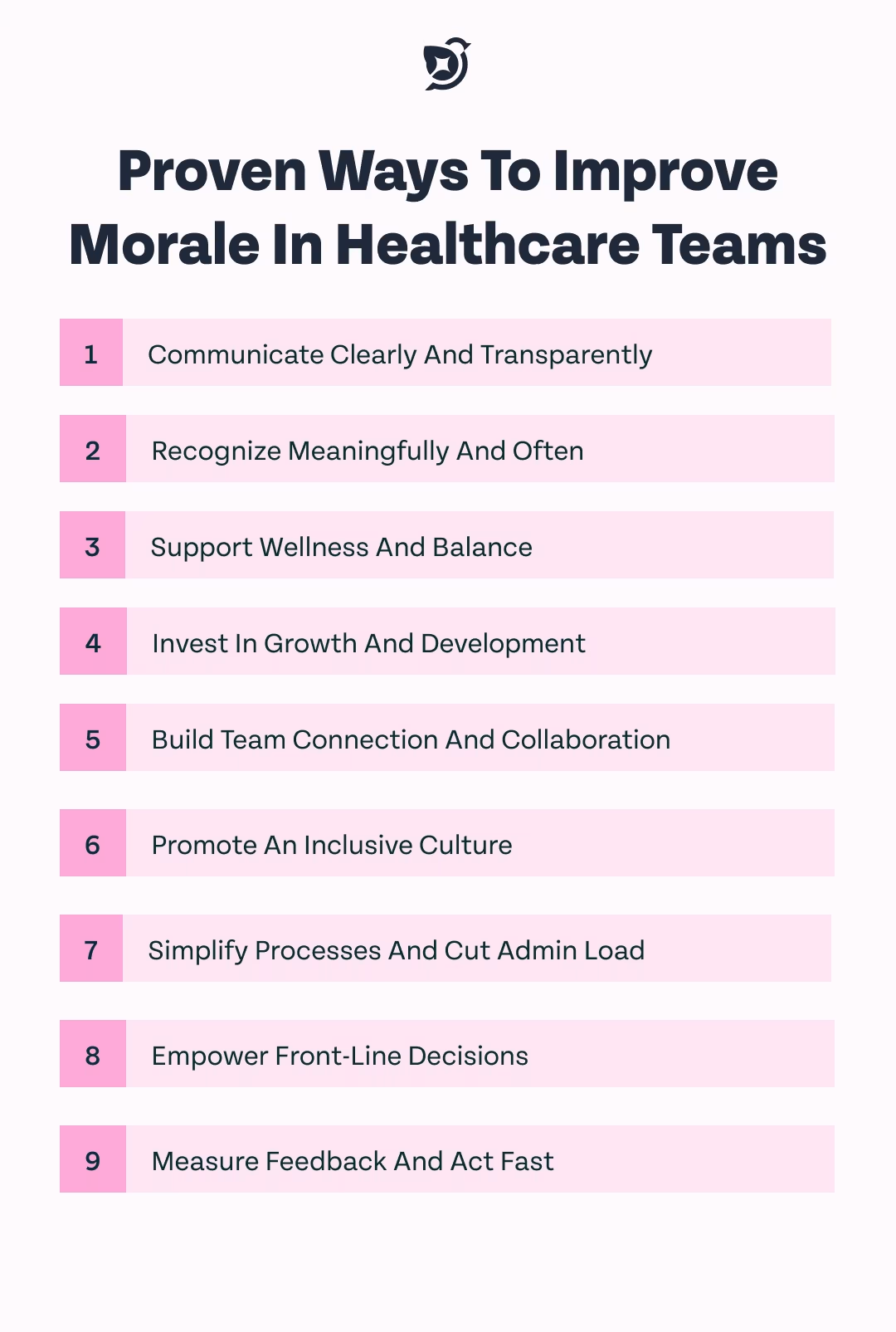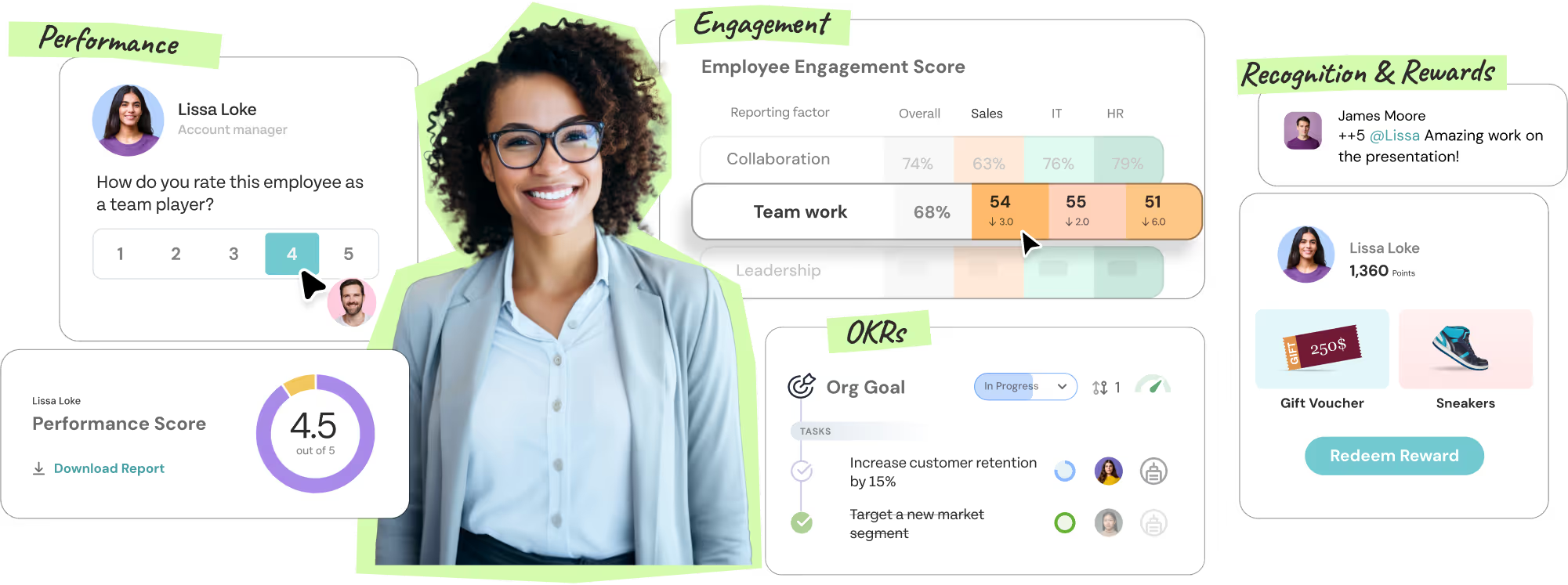Healthcare professionals carry an enormous weight on their shoulders every single day. When they walk into hospitals and clinics, they're not just clocking in for work—they're preparing to make life-and-death decisions under intense pressure. Here's what's fascinating: when these dedicated caregivers feel engaged and valued, it shows in everything they do, and patients can absolutely feel the difference. But when burnout and low morale take hold, the quality of care inevitably suffers.
The numbers back this up. Press Ganey's latest workforce data shows that while employee engagement in U.S. hospitals has been slowly climbing since the pandemic—rising from 4.02 out of 5 in 2022 to 4.04 in 2023—nearly one-third of healthcare workers still aren't engaged.
What's more concerning is that disengaged healthcare workers are twice as likely to leave compared to their highly engaged colleagues, fueling the ongoing turnover crisis.
This is why improving employee morale in healthcare isn't just nice to have—it's absolutely essential for both ethical and business reasons. In this blog we will see how to improve employee morale in healthcare in detail.
Why Employee Morale Matters More Than Ever
When healthcare professionals feel good about their work, they communicate better with patients, follow safety protocols more carefully, and collaborate more effectively with colleagues. Research from Compass One Healthcare shows that when employee engagement increases, workers report less job stress, higher satisfaction, better productivity, and stronger relationships with management. These improvements directly translate into better patient experiences and improved quality of care.
The retention benefits are equally important. Press Ganey's 2024 analysis of 2.2 million healthcare workers found that one in five employees left their organization between 2022 and 2023 – and for those with less than two years of experience, that number jumped to one in four. Meanwhile, Gallup research shows that engaged employees result in 21% less turnover in high-turnover organizations and 51% less turnover in low-turnover organizations.
But the impact goes beyond individual retention. When teams have high engagement, they achieve 1 higher productivity and 23% higher profitability. For healthcare organizations, this translates into fewer medical errors, more efficient operations, and better financial health.
Learn more about How to Calculate Employee Engagement Scores to track and measure your healthcare team's engagement improvements over time.
Understanding the Unique Challenges
Before diving into solutions, it's worth acknowledging why healthcare can be particularly tough on morale. The work itself is emotionally demanding – dealing with life-and-death situations, suffering patients, and grieving families takes a psychological toll that most other professions don't face.
Add to this the practical challenges: understaffing that leads to longer shifts, heavy workloads, unpredictable schedules, and complex administrative requirements. When communication from leadership is poor or recognition is scarce, it's easy for healthcare workers to feel undervalued despite their crucial role.
The COVID-19 pandemic intensified all of these pressures, creating what many call a "turnover tsunami" that the industry is still working to address.
Proven Ways to Improve Morale in Healthcare Teams
The good news? Organizations across the country have successfully turned around low morale with targeted approaches. Here's what research and real-world experience show works best:
1. Keep Communication Clear and Transparent
Healthcare workers make life-saving decisions based on information, yet they're often the last to know about organizational changes that affect their work. This disconnect undermines trust and engagement.
Smart healthcare leaders are changing this by establishing regular communication channels. During the early days of the pandemic, one Boston teaching hospital held daily briefings where leaders shared updates, listened to front-line concerns, and explained the reasoning behind new protocols. Staff reported feeling more supported because they understood the "why" behind decisions and could voice their questions directly.
The key is creating two-way communication. This might include regular town halls, accessible digital dashboards showing key metrics, or simple feedback systems that actually get used. When employees feel heard and informed, psychological safety improves dramatically.
2. Make Recognition Meaningful and Regular
Here's something that costs almost nothing but delivers huge returns: genuine recognition. The simple act of acknowledging someone's effort – not just outcomes, but the daily dedication healthcare workers show – can significantly boost morale.
Research shows that employees are 2.7 times more likely to be engaged when they believe they will be recognized. This doesn't require expensive programs. Verbal praise during staff meetings, handwritten notes from supervisors, or highlighting specific examples of compassionate care all make a difference.
The most effective recognition ties back to organizational values, like giving a "Patient Advocate" recognition when someone goes above and beyond to comfort a worried family member.
Learn proven strategies for Employee recognition programs that go beyond traditional annual awards.
3. Support Mental Wellness and Work-Life Balance
You can't pour from an empty cup, and this is especially true in healthcare. Smart organizations are investing in their employees' mental wellness through dedicated mental health days, flexible scheduling when possible, and comprehensive wellness programs.
According to research, employees who believe they have a positive work-life balance are 21% more productive and dedicated than those who don't. Partner with an Employee Assistance Program to provide confidential counseling and mindfulness workshops. Redesign break rooms to include comfortable seating, natural light, and healthy snacks – creating spaces where staff could actually recharge during breaks.
The result? Lower absenteeism and higher employee satisfaction. The lesson here is that resilience isn't built through constant hardship; providing rest and resources allows healthcare workers to return to their roles renewed and ready to provide excellent care.
4. Invest in Professional Growth
One of the biggest reasons healthcare workers leave is lack of growth opportunities. When people can see a path forward in their careers, they're much more likely to stay engaged and committed.
This might include tuition reimbursement for continuing education, mentorship programs that pair experienced staff with newer employees, or access to online courses and certifications. The LEAD approach – Listen, Encourage, Acknowledge, and Develop – provides a framework for creating meaningful development opportunities. When organizations invest in their people's futures, employees respond with loyalty and bring fresh insights back to patient care.
5. Foster Team Connection and Collaboration
Healthcare work can feel isolating, especially on specialized units or during night shifts. Creating opportunities for colleagues to connect and collaborate strengthens the entire team.
Some organizations have found success with interdisciplinary "huddles" where different departments share updates and insights. Others organize team-building activities, volunteer opportunities, or wellness challenges that bring people together around shared goals.
Even simple activities like department swap days, where staff shadow another team for a shift, can build empathy and understanding across roles. These activities remind healthcare workers of the larger impact of their profession and build the social connections that make work more fulfilling.
6. Create an Inclusive Environment
When people feel they can bring their whole selves to work, engagement naturally follows. This means actively promoting diversity, equity, and inclusion through policies, training, and leadership actions.
For more inspiration on building positive workplace cultures, explore our guide to 20 Work Culture Examples That Boost Employee Engagement.
7. Streamline Processes and Reduce Administrative Burden
Nothing kills morale faster than spending hours on paperwork when you could be caring for patients. Smart use of technology can free up time for what healthcare workers really want to do – provide excellent patient care.
This might mean implementing electronic health record systems with voice dictation to reduce documentation time, automated scheduling tools that ensure fair shift distribution, employee engagement software to enable timely peer recognition and proper feedback systems, pulse surveys to spot burnout or disengagement earlier, or digital handoff systems that improve communication between shifts.
8. Empower Front-Line Decision Making
Healthcare workers are closest to the day-to-day realities of patient care, yet they're often excluded from decisions that affect their work. Involving nurses, technicians, and support staff in decisions about workflow, equipment, and care protocols increases both ownership and morale.
When people feel their expertise is valued and they have a voice in how work gets done, engagement naturally increases. This doesn't mean every decision needs to be made by committee, but it does mean regularly seeking input from those who will be most affected by changes.
9. Measure and Act on Feedback
You can't improve what you don't measure. Regular assessment of employee morale through surveys, focus groups, and stay interviews provides valuable insights into what's working and what needs attention.
Simple approaches like "Pulse feedback Fridays" with ultra-short surveys containing 1-2 questions can help track morale trends without overwhelming staff. The crucial element here is closing the feedback loop. When staff see that their input leads to actual changes – whether it's introducing mental wellness days, improving the scheduling system, or addressing communication issues – trust and engagement grow significantly.
Discover more about implementing effective Employee Pulse Surveys to capture real-time feedback from your healthcare teams

Real Success Stories
These strategies aren't just theoretical—they deliver measurable results. Here are two compelling examples of healthcare organizations that transformed their workplace culture through targeted engagement initiatives.
Case Study 1: From Crisis to Excellence in Rural Minnesota

The Challenge:
In 2018, Ely-Bloomenson Community Hospital (EBCH) in Minnesota was facing a morale crisis. Employee engagement scores had plummeted to the 16th percentile—meaning 84% of comparable healthcare organizations were performing better. Voluntary turnover was climbing, and staff surveys revealed widespread feelings of being undervalued despite their dedication to patient care.
The Intervention:
EBCH partnered with Bucketlist Rewards to implement a comprehensive recognition platform combined with leadership coaching initiatives. The approach focused on making recognition meaningful, frequent, and tied to the hospital's core values. Leaders were trained to spot and acknowledge not just big wins, but the daily acts of compassion and excellence that define quality healthcare.
The Results:
The transformation was remarkable. Within just one year, engagement scores soared from the 16th percentile to the 96th percentile—placing EBCH among the top-performing healthcare organizations nationally. Even more impressive, voluntary turnover dropped to minimal levels, with many months reporting zero departures.
Why It Worked:
As Martin, a hospital administrator, explained: "When employees feel genuinely appreciated for their contributions—not just during annual reviews, but in real-time for the compassionate care they provide daily—everything changes. Our staff went from feeling overlooked to feeling like the heroes they truly are."
The key was consistency and authenticity. Recognition wasn't just about major achievements; it celebrated the ICU nurse who stayed late to comfort a family, the housekeeper who went out of their way to brighten a patient's day, and the lab technician whose attention to detail prevented a potential error.
Case Study 2: Technology Meets Compassion in Los Angeles
The Challenge:
Los Angeles General Medical Center was struggling with nurse retention and communication gaps between front-line staff and leadership. Nurses reported feeling disconnected from decision-makers and frustrated that their insights about patient care weren't being heard or acted upon.
The Innovation:
The hospital implemented the Joslin Insight application—a mobile platform that enabled real-time feedback from nurses directly to the Chief Nursing Officer. This wasn't just another survey tool; it was designed for busy healthcare professionals to share concerns, suggestions, and wins as they happened, not weeks later during formal meetings.
The Results:
During the study period, turnover rates among participating nurses dropped by 22%. Perhaps more telling, 90% of participants believed the application either contributed to or had the potential to improve communication with their leaders. Patient satisfaction scores also improved as nurses felt more empowered to advocate for care improvements.
The Broader Impact:
The success extended beyond retention numbers. Nurses began proactively sharing insights about workflow inefficiencies, safety concerns, and opportunities to enhance patient experience. One nurse's real-time feedback about medication delivery timing led to a process change that improved patient comfort and reduced call light usage by 15%.
What Made the Difference:
The technology succeeded because it addressed a fundamental human need—the desire to be heard and to know that your expertise matters. As one participating nurse noted: "For the first time, I felt like my voice could reach leadership without going through layers of bureaucracy. When I saw my suggestions actually implemented, it reminded me why I became a nurse in the first place."
While these success stories demonstrate the power of targeted engagement solutions, healthcare organizations need comprehensive platforms that combine recognition, real-time feedback, and development tools in one seamless system.
ThriveSparrow delivers exactly this integration—combining Kudos for peer recognition, Pulse Surveys for real-time feedback, and Personal Development Plans for career growth in one comprehensive platform built for healthcare teams. Instead of juggling multiple vendors and complex integrations, ThriveSparrow provides the complete engagement solution that transforms healthcare workplaces from crisis to excellence.

Key Lessons for Healthcare Leaders
Both case studies demonstrate that successful morale improvement isn't about expensive overhauls—it's about creating systems that make healthcare workers feel valued, heard, and empowered. Whether through recognition platforms or communication technology, the common thread is acknowledging that front-line healthcare workers possess invaluable insights and deserve genuine appreciation for their dedication.
The return on investment speaks for itself: higher engagement, lower turnover, improved patient satisfaction, and renewed sense of purpose among staff. In an industry where the human element is irreplaceable, investing in employee morale isn't just good management—it's essential for fulfilling healthcare's fundamental mission.
Moving Forward: Small Steps, Big Impact
As Florence Nightingale, the pioneer of modern nursing, once said: "Nursing is a progressive art such that to stand still is to go backwards". This wisdom applies to employee morale as well – maintaining the status quo isn't enough when your workforce is struggling.
The encouraging news is that improving employee morale doesn't require massive budget increases or complete organizational overhauls. Often, the most impactful changes are the simplest: better communication, genuine recognition, support for mental wellness, and involving employees in decisions that affect their work.
Research consistently shows that employee engagement drives better patient outcomes, improved financial performance, and reduced turnover. When healthcare professionals feel valued, supported, and empowered, they bring compassion, creativity, and resilience to their roles – exactly what patients and communities need.
The path forward requires commitment from leadership, but the returns are substantial. By investing in employee morale, healthcare organizations aren't just improving their workplace culture – they're strengthening their ability to fulfill their mission of providing excellent patient care. And in an industry where the human element is irreplaceable, that investment in people always pays dividends.
If your real goal is to improve healthcare employee morale but you’re stuck figuring out how, our ThriveSparrow experts can help. Reach out today and get hands-on with ThriveSparrow — try it free for 14 days and start improving engagement across your healthcare teams.
FAQs
1. What are common causes of low morale among healthcare workers?
Factors such as heavy workloads, unclear communication, lack of recognition, and feeling excluded from decisions often undermine morale.
2. How quickly can morale improvements impact patient care?
Even simple changes—like regular feedback and meaningful recognition—can begin improving staff morale and thus patient-experience outcomes within months.
3. What role does leadership communication play in morale?
Transparent, two-way communication builds trust, gives staff a voice, and helps them feel valued, which boosts morale and engagement.
4. Can investing in training and development really improve morale?
Yes – when healthcare staff see clear growth pathways and feel their skills are growing, their morale and retention both improve.
5. How should healthcare organizations measure improvements in staff morale?
Use regular pulse surveys, track turnover and absenteeism, and monitor feedback channels to measure morale trends and identify issues early.
















